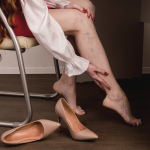
Causes and Treatments of Leg Swelling
Leg Swelling Related to Inflammation
Leg swelling due to inflammation can be caused by an underlying health condition. The surface of the endothelium is usually smooth and allows blood to flow freely. However, increased intravenous pressure, such as valve dysfunction or activity involving prolonged standing or sitting, can damage the lining. It triggers an inflammatory process that leads to white blood cells and other elements of the healing process to repair the injury. Chronic inflammation of the veins disrupts blood flow, increases blood pressure in the veins, and leaks liquid portions of blood into surrounding tissues, causing swelling.
Also, kidney, heart, liver disease, or certain medications can cause swelling of the lower limbs. Treatment: Lower limb swelling should always be monitored by a doctor who can conduct a thorough examination and accurate diagnosis. Swelling of the lower limbs caused by venous valve dysfunction or inflammation due to chronic venous insufficiency can be treated with VenaSeal ™. VenaSeal ™ is a minimally invasive surgery that is virtually painless, takes only 20 minutes in our clinic, and allows patients to resume normal activities on the same day.
Leg Swelling Related to Fluid Buildup
Many factors other than inflammation can cause leg swelling due to the accumulation of water in the legs. Among which:
- Obesity:
Excess abdominal fat in obese people puts pressure on the lower abdomen and blocks the flow of venous blood from the legs. Studies were conducted to simulate this effect, and the researchers placed pressure cuffs around the abdomen of non-obese volunteers. The results showed that the pressure in the leg veins increased, venous congestion occurred and blood flow in the legs slowed. Additionally, adipose tissue secretes hormones and other signaling molecules known to disrupt endothelial function. This can interrupt and slow venous blood flow, increase venous pressure, and eventually lead to swelling of the lower limbs.
Treatment: Weight loss is the best permanent treatment. By losing weight, you can easily perform the exercises necessary for healthy blood circulation. It also reduces or eliminates other risk factors for lower limb swelling, such as heart disease and diabetes.
- Sitting for Long Periods of Time:
Whether you’re sitting on a desk, on a long-haul flight, or a long-haul flight, sitting for long periods of time can slow blood circulation and reduce venous circulation in the legs. This happens because when seated the legs are lower than the heart and the venous blood must move against gravity and return to the heart and lungs. Even in a sitting position, the hips can bend and the pressure on the blood vessels in that area can increase. It goes without saying that sitting is an inactive activity. While sitting, your blood circulation naturally slows down and is not aided by the muscle pump mechanism which helps restore blood flow as you walk.
The combination of all these factors causes dangerous activity in the circulatory system of the legs when sitting for long periods. Due to the effects of sitting, even healthy young people suffer from swollen feet.
Treatment: Eliminating prolonged sitting during intermittent activity reduces accumulated swelling and aids in blood movement. In one study, 3 minutes of physical activity per hour during a 4-hour session reduced lower limb swelling and decreased levels of pro-inflammatory markers. The burst of activity resulted in a gentle cycle, a 20-second sprint, followed by a 95-second cool-down. If you are unable to train for a short time while sitting, such as during a long flight, you can prevent or reduce leg swelling by exercising your ankles. By following and rowing the alphabet with the toes (i.e. pointing and bending the ankle), the circle of the ankle activates a calf muscle pump that pushes venous blood from the legs to the heart. Compression stockings are also useful in these cases.
- Standing for Long Periods of Time:
Prolonged standing, like sitting, requires blood to be moved from the feet and legs against gravity without the assistance of the calf muscles providing pressure against the veins. Occupations that involve long periods of standing are associated with higher risk for leg swelling that can lead to varicose veins. And, as for sitting, this tendency doesn’t discriminate by age. Research shows that even healthy young adults experience measurable leg swelling and muscle fatigue after long bouts of standing[7].
How to Treat: Ankle and hip range of motion exercises can help counteract the effects of prolonged standing. In one study, participants stood for 4 hours, during which they practiced either ankle exercises (wiggling the toes) or hip exercises (knee raises) every thirty minutes. Ankle exercises resulted in 40% less leg swelling and hip exercises resulted in 20% less swelling compared to standing for the same amount of time without performing these exercises.
Additionally, the type of shoes you wear and the type of floor you stand on can help or hurt your legs. If possible, wear athletic shoes and stand on shock absorbing mats. These reduce impact on your muscles and joints resulting in less swelling, less fatigue, and greater comfort.
Deep Vein Thrombosis (DVT) or Thrombophlebitis
Deep vein thrombosis (DVT) is a blood clot in a vein near the center of the leg. These can remain asymptomatic until they become large enough to adhere to the venous wall. When this happens, it triggers an inflammatory response and the affected leg quickly swells and becomes painful. DVT can be a life-threatening embolism or pulmonary embolism when a small piece of blood clot breaks and travels to the lungs through the venous circulation, which can be emergency medical help. For this reason, leg swelling should always be diagnosed and treated by a qualified doctor.Thrombophlebitis is a key inflammatory condition that leads to the formation of blood clots. Thrombophlebitis can cause blood clots in superficial (surface or deep veins) veins. Superficial thrombophlebitis has no risk of pulmonary embolism and can be treated at home. Treatment method:Leg Height: Uses gravity to promote blood flow and reduce swelling. Ideal when the lower limbs are above the height of the heart. Compression stockings – Promote the recovery of blood flow and prevent swelling of the feet. If height isn’t an option, you can use compression stockings. Squeezing hot or salt water stimulates blood flow and soothes the feet. Both appear to have the same effect. This should ideally be done for 30 minutes 3-4 times a day.
Chronic Venous Insufficiency
Chronic venous insufficiency is a condition in which the venous valves in the legs do not function properly and / or damage the lining of the veins, resulting in decreased blood flow, increased blood pressure in the veins, fluid loss and swelling.Treatment method: Raise your legs: This can immediately relieve discomfort and reduce swelling. Aim for 15 minutes per session, 2-4 times a day. According to a 2019 review of chronic venous insufficiency studies in elderly patients, compression stockings can also prevent swelling and reduce the risk of ulcer formation. Exercise – Walking strengthens the calf muscles and activates pumping of the calf muscles. Start slowly and gradually increase the distance and speed under the supervision of your doctor. Also effective strengthening exercises with calf movement and resistance bands that help accelerate the progress of the walking routine.Herbal Supplements Medicinal herbs and plant extracts such as quercetin, pine bark extract, ginkgo leaves and butcher’s broom contain high levels of flavonoids with antioxidant and anti-inflammatory properties that aid blood circulation in the legs.



